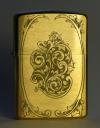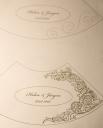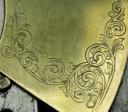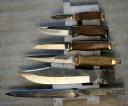This time I have a special treat for you. An interview with a very talented man – Jacques Herbst. He is participant in iGraver engraving forum, just like me, and has been engraving about a year. With his permission I post here his latest ‘practice’ engraving on a knife, which I personally think is just a world-class work.

Please tell us a little about yourself, who you are, where do you come from, what is your background?
My name is Jacques Herbst. I live on a farm near a small town called Kokstad in South Africa.
What is your day-job?
I run a small jewelery manufacturing shop and I am a goldsmith and set stones.
When did you start engraving, why?
I started about a year ago. I like things challenging and artistic and engraving fills the gap.
What is the most exciting thing about engraving?
I think cutting cause its the time you get to see your creation coming to live.
Where do you find inspiration for your engraving designs?
That’s a hard one. I just draw till I get something that I am happy with.
Who are your idols, if any, in engraving world? Why?
I don’t really have one but there is one person who’s talent I respect and thats JC Randell. I just like the way he cuts.
On a usual week, how much time do you engrave? How much time you spend on drawing the designs?
Drawing and cutting takes the same time for me. Most of the time its more time spent drawing than engraving. I spend as much time as I am allowed in a week as I have to work to support my hobby’s.
What tools do you use now and what did you use when you started to learn this art form?
I use a Classic Airgraver (note: it’s Lindsay made) and started with push gravers, but found it hard to control at best. Air tools just makes cutting and learning so much easier and faster and as a beginner I needed all the help I could get.
Any suggestions or tips for people who would like to give a try on engraving?
You have to be dedicated to this art form as it is not quick or easy but it rewards you if you spend the time. Start simple and work your way up as your skills grow. You need to learn how to draw and practice drawing as it is the most important thing in engraving. Learn the basics of scroll design. Once you get a grip on the basics its time to have some fun and show your creative side. Leave the expensive items till you get some skill and experience under your belt then engrave them. Join all the engraving forums, they are free and there is so much info on them.
In the future, do you want the engraving to be an hobby or profession?
Profession.
Your favorite quote? Why?
“Progress takes the form of practice, refinement of technique, and learning what to use the skills for” by Betty Edwards. If you want to learn, you need practice.
Well, that’s the interview. Thank You Jacques for taking the time! I’m sure it’s not before too long that you’re able to make living by engraving, you have great skills and even greater designs.
I hope it gave some more insight what engraving is and how it’s done.
























